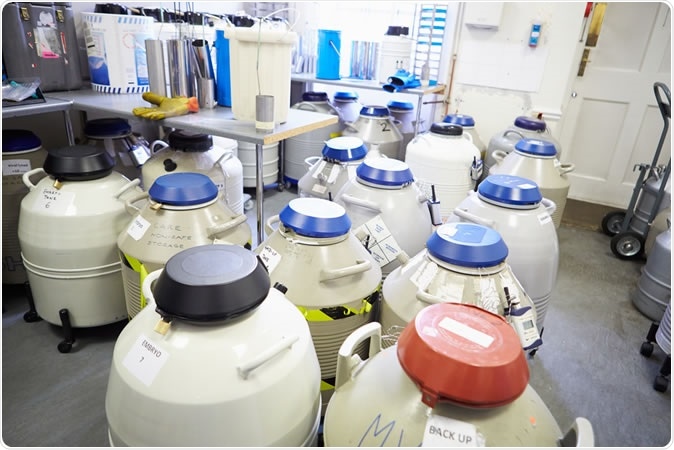In pursuit of greater acceptance for HIV positive people, an organization in New Zealand aspires to begin an HIV positive sperm bank called Sperm Positive. It will start by accepting sperms from 3 males who have HIV but are being treated such that their sperm is not capable of transmitting the infection at present. The treatment has reduced viremia (the viral load in the blood) to such a level that it is undetectable by standard methods.

Frozen storage at sperm bank. Image Credit: Monkey Business Images / Shutterstock
The male donors are still HIV positive, but cannot infect anyone even through unprotected sex, or by vertical transmission (from one generation to the next). One of the donors has revealed his name – Damien Rule-Neal, who became a person living with HIV in 1999 and began treatment about 18 years ago. Now his virus levels are undetectable. He claims that many of his friends also have HIV but have fathered children. He would like more people to become aware of what it means to have undetectable virus status.
The bank will start functioning just before World AIDS Day on December 1.
Accepting HIV positive people
The primary aim of the Sperm Positive project was to help others with HIV to gain acceptance by showing that people living with HIV (PLWH) still go on living and should not be treated as untouchables. It was set up by the New Zealand Aids Foundation, Positive Women Inc and Body Positive and hopes to help people understand more about how the virus is transmitted.
The bank will not be an infertility treatment center, but if both the sperm donor and the ovum donor agree to a match, it will coordinate the use of its stored sperm via local fertility clinics. It will allow HIV positive people to donate sperms that are safe for reproductive purposes, and potentially father babies, as well as help them understand the availability of fertility clinics for their needs.
All individuals who approach the bank hoping to receive sperm to create a baby will be told clearly that the donor has HIV but has undetectable levels of the virus, because of the effective antiretroviral therapy (ART) they are on.
Lessening the stigma associated with HIV will have a positive fallout. In the words of infectious diseases specialist Mark Thomas, “Stigma can lead to inconsistent taking of medicines, and result in much less effective treatment of HIV, and risk of transmitting HIV. Fear of stigma and discrimination can stop people at risk from getting tested, and those living with HIV from accessing treatment and support.”
This doctor has been treating HIV positive patients for over 3 decades now and says he has witnessed constant changes in the way the public views this condition. Despite significant progress in changing public perceptions, stigma is still a problem with PLWH, according to him.
Public avoidance of PLWH
A new study released by Prevention Access Campaign and Merck Pharmaceuticals shows just how widespread public avoidance of PLWH is. No less than 30% of people aged between 23 and 26 years who are HIV negative say they do not wish to be friends or have any kind of social interaction with PLWH. This includes talking to them, and hugging them, even though this kind of casual contact does not cause the virus to spread.
Hispanic and African-American individuals responded to the survey in the same manner, with 34% saying they have refused to shake hands, and do not share food, drinks or eating utensils with PLWH.
Despite the ongoing Undetectable-Untransmittable campaign which seeks to drive home the message that people with HIV cannot transmit it once the viremia drops below detectable levels, this knowledge is confined to less than a third of the population, says the survey. More than 50% still thought that even with undetectable virus levels in blood, transmission was still possible.
Calling this “a disturbing trend”, the Prevention Access Campaign’s Bruce Richman said, “Young adults overwhelmingly are not being informed effectively about the basics of HIV.” He wants young people in America to talk about HIV and healthy sexual activity, as well as to start up more engaging programs to help PLWH avoid stigma.
The US HIV epidemic rages
Young people in the US are at the highest risk for a new diagnosis of HIV, with rising rates in this age group despite an overall stable rate of diagnosis. This shows a continuing HIV crisis in the country. To control this epidemic, Merck’s Peter Sklar says, ““We must continue to search for ways to better understand young people’s perceptions of HIV, promote safer sex behaviours and drive education and action in this population.”
Implications
Of course, people who have contracted the infection through homosexual or casual sexual contacts must be treated, but should they be pitied and cosseted as if they were victims, for suffering the consequences of their own choices? This question is bound to occur to every thinking person in view of the many millions of people suffering from curable diseases for no fault of their own, with no end in sight because of “lack of funding”, while HIV research and initiatives to help PLWH seem to draw on a bottomless purse.
It would seem more sensible, to the lay observer, to curtail promiscuous sex and promote self-control, which are time-tested ways to prevent HIV transmission, rather than research studies on the stigma suffered by PLWH, HIV testing campaigns and gimmicks like an HIV-positive sperm bank to increase social acceptance of people who have taken the risk and acquired this sexually transmitted disease – which would appear to be a clear case of “locking the stable door after the horse has bolted.”